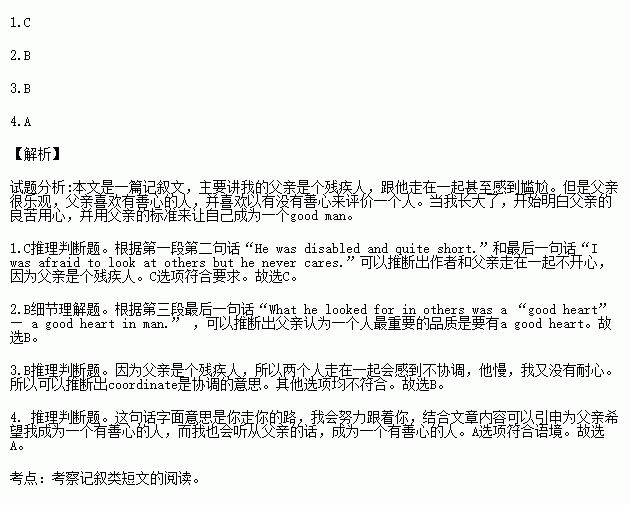题目内容
When I was growing up, I was unhappy to be seen with my father. He was disabled and quite short. He used to walk together with me and his hand was on my arm for balance. At this time, people would look at us strangely. I was afraid to look at others but he never cares.
It was difficult to coordinate our steps — his slow, mine impatient. But each time, he always said, “You set the pace, I'll follow you.”
He never talked about himself as a disabled man and nor did he envy other people’s good fortune or health. What he looked for in others was a “good heart” — a good heart in man.
Now that I am older, I believe that is a right standard to judge people, even though I still don’t know exactly what a “good heart” is. But I know the times when I don’t have it. Unable to take part in many activities, my father still tried to participate in some way. When I played ball, he “played” it too. When I joined the Navy, he “joined” too. He often introduced me, saying “This is my son, but it is also me, and I could have done this if things had been different.”
He has been gone many years, but I am so sorry for my unwillingness to walk with him. I never told him how I regretted it. I think of him often when I complain about small affairs and when I don’t have a “good heart ”. At such times, I want to put my hand on his arm and say, “You set the pace, I'll try to follow you. ”
1.The author felt unhappy walking with his father because ______.
A. he was pitiful for his father’s disability
B. it was easy for them to walk together
C. he didn’t want others to know he had a disabled father
D. his father often blamed him
2.In his father’s view, the most important quality a good person should have is ______.
A. excellent health B. a good heart
C. smart hands D. beautiful appearance
3.What does the underlined word “coordinate” mean?
A.行走 B.协调 C. 抚平 D. 暂停
4.According to the last paragraph, by saying “You set the pace. I will try to follow you.” the author means that ______.
A. he will follow father’s standards of being a good man
B. his father didn’t participate in any activities
C. he is glad to walk on his own
D. he still cares more about the appearance


